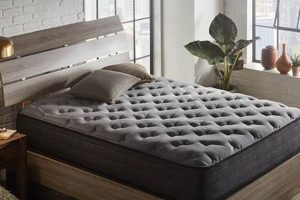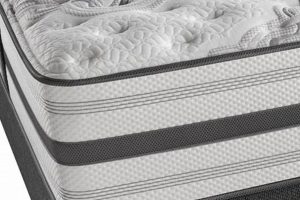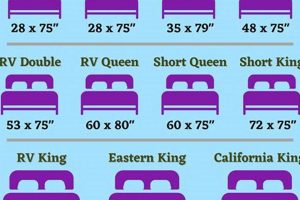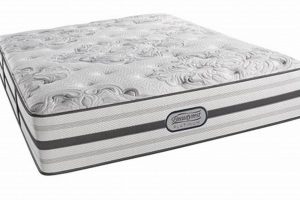A bed size dimensionally defined by a narrow width and extended length, it typically measures approximately 39 inches wide and 80 inches long. This configuration provides additional legroom, making it suitable for taller individuals who might find a standard twin size insufficient. A common application is in college dormitories, offering a space-saving solution for students while accommodating various heights.
The advantages of this specific size include enhanced comfort for taller sleepers, particularly beneficial for those who tend to feel constricted on shorter mattresses. Historically, its prevalence increased with the growing emphasis on providing adequate sleeping accommodations for diverse populations, leading to its widespread adoption in institutional settings and eventually, residential use. The elongated design promotes better spinal alignment and reduces the likelihood of discomfort caused by limbs extending beyond the mattress edge.
The subsequent sections will delve into the specific factors to consider when selecting this particular bed type, including material composition, support systems, and optimal uses, as well as the various bedding options and accessories designed to complement its unique dimensions.
Considerations for Selecting an Extended Twin Mattress
The selection of an extended twin mattress requires careful evaluation to ensure optimal sleep quality and suitability for the intended user. Factors extending beyond mere size must be considered.
Tip 1: Assess Sleeper Height: Determine the height of the intended user. Individuals exceeding six feet in height will likely benefit most from the additional length. Proper leg support is crucial for restful sleep.
Tip 2: Evaluate Support System: Examine the internal support structure. Innerspring, memory foam, and hybrid models offer varying levels of support. Choose a system that aligns with the sleeper’s weight and preferred sleeping position.
Tip 3: Consider Material Composition: Materials impact comfort and temperature regulation. Memory foam conforms to the body, while innerspring mattresses provide greater breathability. Consider hypoallergenic options for sensitive individuals.
Tip 4: Research Firmness Level: Firmness is subjective but crucial. Side sleepers often prefer softer mattresses, while back and stomach sleepers typically benefit from firmer support. Test different firmness levels when possible.
Tip 5: Check Mattress Thickness: Thickness contributes to overall comfort and support. Thicker mattresses generally offer greater durability and pressure relief. Consider the frame’s compatibility with the mattress height.
Tip 6: Review Warranty and Return Policies: Examine the manufacturer’s warranty and return policies. A longer warranty indicates greater confidence in the product’s longevity. Understand the terms and conditions before purchase.
Tip 7: Inquire About Certifications: Look for certifications such as CertiPUR-US, which ensures the mattress meets certain standards for emissions and durability. These certifications provide assurance of product quality.
Selecting the correct mattress involves careful consideration of factors beyond just size. Prioritizing support, materials, and firmness will significantly enhance the sleeper’s experience.
The following section will provide information on available bedding and accessories designed specifically for this bed size, and how to ensure a proper fit.
1. Dimensions
Dimensionality constitutes a defining characteristic of any mattress, and in the specific case of the extended twin, it dictates the suitability for intended users. Standard dimensions for this type of mattress are typically 39 inches in width and 80 inches in length. This elongated form factor directly addresses the needs of taller individuals who require additional legroom, thereby preventing discomfort and promoting better sleep posture. For example, a college student exceeding six feet in height would find a standard twin mattress insufficient, potentially leading to restless sleep due to inadequate support. The extended length mitigates this issue.
Deviation from these established dimensions impacts its classification and use. A mattress measuring shorter than 80 inches in length, despite maintaining a 39-inch width, would not qualify as an extended twin. Conversely, alterations to the width would result in a categorization as a different mattress type altogether. Understanding precise dimensions is crucial when selecting appropriate bedding, as standard twin sheets are incompatible. Bedding manufacturers produce linens specifically tailored to fit the unique dimensions of the extended twin, ensuring a snug and secure fit. These tailored dimensions are critical to ensure safety standards are met on children’s and dorm rooms.
In summary, dimensionality is fundamental to defining and differentiating it from other mattress types. The 39-inch width and 80-inch length are non-negotiable characteristics that determine its appropriateness for taller individuals and its compatibility with specialized bedding. Accurate measurement and adherence to these standards are essential for optimal user experience and product classification, preventing misuse and ensuring safety, this is the key.
2. Support
Support is a fundamental element in the design and selection of any mattress, and its significance is amplified in the context of the extended twin due to the typical user profile: taller individuals and often students. A well-supported mattress promotes proper spinal alignment, pressure relief, and overall sleep quality.
- Core Construction and Reinforcement
The core construction directly impacts the level of support provided. Innerspring systems, for instance, utilize coils to distribute weight, while memory foam relies on density and contouring. Hybrid models often combine both for balanced support and comfort. Reinforcement along the edges is crucial, particularly for a smaller mattress often placed against a wall, as it prevents sagging and ensures consistent support across the entire surface. Without adequate edge support, the mattress will degrade faster especially with a taller user.
- Zoned Support Systems
Zoned support systems address the varying support needs of different body regions. These systems often incorporate different coil densities or foam formulations in specific zones to provide targeted support to the shoulders, hips, and lumbar region. For the user on a twin extra long mattress, especially those with pre-existing back issues, zoned support can significantly improve sleep quality and reduce pain.
- Weight Distribution and Capacity
A mattress’s weight distribution capability dictates its ability to evenly distribute the sleeper’s weight, minimizing pressure points. The weight capacity of the mattre
ss, determined by its construction and materials, is equally important. Exceeding the weight capacity can compromise support and reduce the mattress’s lifespan. For college students of varying weights, choosing a mattress with a suitable weight capacity is essential for long-term durability and sustained support. - Foundation Compatibility
The type of foundation used beneath the mattress significantly influences its overall support and longevity. Solid platforms, box springs, and adjustable bases each provide different levels of support and impact the mattress’s performance. Selecting a compatible foundation is crucial for maximizing the support benefits and preventing premature wear and tear. Using an unsupportive foundation may void a warranty and can reduce a mattress lifespan.
These support facets are not mutually exclusive; rather, they interact to determine the overall performance and suitability of the extended twin mattress. Neglecting any of these factors can compromise comfort, spinal alignment, and the long-term durability of the mattress, thus impacting the investment and the overall sleep experience. Properly understanding how support is achieved will assist in appropriate mattress selection.
3. Materials
The selection of materials is a pivotal aspect influencing the comfort, durability, and overall performance of a twin extra long mattress. The constituent materials directly determine the level of support, temperature regulation, and hypoallergenic properties, thereby impacting the sleep experience.
- Foam Density and Composition
Foam density, measured in pounds per cubic foot, dictates the support and longevity of the mattress. Higher density foams, such as those found in memory foam mattresses, offer enhanced pressure relief and resistance to sagging over time, particularly crucial for taller individuals using an extended twin. The composition of the foam, whether it be polyurethane, memory foam, or latex, influences factors like breathability and responsiveness. For example, open-cell memory foam promotes airflow, mitigating heat retention, a common concern for some sleepers.
- Coil Type and Count
In innerspring or hybrid mattresses, the type and number of coils determine the level of support and motion isolation. Individually pocketed coils, for instance, minimize motion transfer, an important consideration for shared sleeping spaces such as dormitories where an extended twin may be used. A higher coil count generally translates to greater support and durability. The gauge of the coil, a measure of its thickness, also affects firmness and support. Thicker coils provide a firmer feel, while thinner coils offer a softer, more conforming surface.
- Cover Fabric and Construction
The cover fabric serves as the first point of contact between the sleeper and the mattress, influencing comfort and breathability. Materials like cotton, rayon, and polyester are commonly used, with variations in weave and knit affecting air circulation and moisture-wicking properties. Some covers incorporate specialized treatments, such as antimicrobial agents or cooling technologies, to enhance hygiene and temperature regulation. The construction of the cover, including quilting patterns and thickness, also contributes to the overall feel and durability of the mattress.
- Fire Retardant Barriers
Federal regulations mandate that all mattresses include a fire retardant barrier to enhance safety. These barriers can be composed of various materials, including chemically treated fabrics, silica, or wool. The choice of fire retardant material can impact the mattress’s overall comfort and breathability. Natural fire retardant options, such as wool, are often preferred for their inherent flame resistance and moisture-wicking properties, minimizing potential off-gassing and promoting a healthier sleep environment.
The interplay of these material aspects collectively determines the quality and suitability of a twin extra long mattress. A comprehensive understanding of these materials enables consumers to make informed decisions aligning with their specific needs, preferences, and budgetary considerations.
4. Firmness
Firmness, a tactile characteristic that quantifies the resistance a mattress offers to compression, is a critical determinant in the suitability and overall comfort provided by any mattress, including the extended twin. This characteristic directly impacts spinal alignment, pressure distribution, and the overall quality of sleep. The correct firmness level mitigates discomfort and enhances restorative sleep, particularly for taller individuals and students frequently associated with extended twin usage.
The selection of appropriate firmness is subject to individual sleeping preferences and body weight. Side sleepers typically benefit from a softer mattress, as it allows the shoulder and hip to sink in, maintaining spinal alignment. Conversely, back and stomach sleepers often require a firmer surface to prevent excessive sinking and maintain a neutral spine. The correlation between firmness and body weight is equally important; individuals with higher body weight generally necessitate a firmer mattress to provide adequate support and prevent bottoming out. For example, a six-foot-tall college athlete weighing 220 pounds would likely require a firmer twin extra long mattress than a lighter individual of similar height to achieve optimal support. Failure to select an appropriate firmness level can lead to discomfort, pain, and disrupted sleep, negating the benefits of the extended length.
In conclusion, firmness is an indispensable component of a twin extra long mattress, exerting a direct influence on sleep quality and physical well-being. The selection of an appropriate firmness level, tailored to individual sleeping preferences and body weight, is paramount. The absence of a properly selected firmness can nullify all the advantages of having an extended twin mattress, leading to ineffective sleep and the potential for pain and long-term discomfort.
5. Lifespan
The lifespan of a twin extra long mattress is a critical consideration, representing the period during which it effectively provides adequate support and comfort. It directly correlates with the mattress’s cost-effectiveness and overall value. A shortened lifespan necessitates premature replacement, increasing long-term expenses.
- Material Quality and Construction
The quality of materials and construction techniques used in manufacturing directly influences the mattress’s lifespan. Mattresses constructed with high-density foams, durable coil systems, and reinforced edge support tend to exhibit greater longevity. For instance, a memory foam mattress with a density of 4 pounds per cubic foot will generally outlast one with a density of 2 pounds per cubic foot. Similarly, innerspring mattresses with tempered steel coils are more resistant to sagging and deformation compared to those with lower-quality coil systems. The use of robust stitching and secure seams in the cover also contributes to its overall durability.
- Usage Patterns and Weight Load
The freq
uency of use and the weight load placed on the mattress significantly impact its lifespan. A mattress subjected to daily use by a heavier individual will likely degrade more rapidly than one used sporadically by a lighter person. Concentrated weight distribution, such as consistently sleeping in the same spot, can also contribute to localized wear and tear. In the context of college dormitories, where twin extra long mattresses are common, the mattress may experience more frequent and varied use, potentially reducing its lifespan compared to residential settings. - Maintenance and Care Practices
Regular maintenance and proper care can extend the lifespan of a mattress. This includes rotating or flipping the mattress periodically to distribute wear evenly, using a mattress protector to shield against stains and spills, and vacuuming the surface to remove dust and allergens. Allowing the mattress to air out occasionally can also help prevent moisture buildup and prolong its freshness. Neglecting these maintenance practices can accelerate the degradation of the mattress and shorten its lifespan.
- Warranty Terms and Conditions
The warranty offered by the manufacturer provides an indication of the expected lifespan and potential defects covered. A longer warranty period typically reflects greater confidence in the product’s durability. However, it is essential to carefully review the warranty terms and conditions to understand the specific exclusions and limitations. Common exclusions may include damage caused by improper use, stains, or normal wear and tear. Understanding the warranty coverage can help consumers make informed decisions and protect their investment.
The lifespan of a twin extra long mattress is a multifaceted characteristic influenced by material quality, usage patterns, maintenance practices, and warranty terms. Prolonging the mattress’s lifespan requires a combination of selecting a well-constructed product, adhering to proper care guidelines, and understanding the limitations of the warranty coverage, enabling consumers to maximize the value and utility of their purchase.
6. Cost
The cost associated with a twin extra long mattress is a multifaceted consideration influenced by material composition, construction quality, brand reputation, and retail location. It constitutes a significant factor in the purchasing decision, directly impacting accessibility and value perception. A higher price point often reflects superior materials, advanced support systems, and enhanced durability, potentially translating to a longer lifespan and improved sleep quality. For instance, a mattress incorporating memory foam with a high density and individually wrapped coils will invariably command a higher price than a basic innerspring model using lower-grade materials. This price differential reflects the investment in comfort, support, and longevity. Conversely, lower-priced options may compromise on these attributes, potentially leading to premature sagging, diminished support, and a reduced lifespan. This is particularly relevant in institutional settings, such as college dormitories, where bulk purchases of twin extra long mattresses necessitate careful cost-benefit analysis.
Several factors contribute to the variability in the cost. Manufacturing processes, including sourcing of materials and labor costs, play a significant role. Mattresses produced domestically may incur higher labor costs compared to those manufactured overseas, impacting the final retail price. Furthermore, brand recognition and marketing expenses contribute to the overall cost. Established brands with extensive advertising campaigns often command premium prices, reflecting their perceived quality and reputation. Retail markups and promotional discounts also influence the final cost. Brick-and-mortar stores typically have higher overhead expenses compared to online retailers, potentially resulting in higher prices. Seasonal sales, clearance events, and promotional offers can provide opportunities to acquire a twin extra long mattress at a reduced cost. Comparing prices across various retailers and monitoring promotional activities is essential for informed decision-making.
In summary, the cost of a twin extra long mattress is a complex interplay of material quality, construction methods, brand reputation, and retail strategies. The informed consumer understands the relationship between cost and value, evaluating the long-term benefits of investing in a higher-quality mattress versus the short-term savings of a lower-priced option. Careful consideration of these factors enables a balanced decision that aligns with individual budgetary constraints and sleep quality expectations. Purchasing decisions should always be done with research to understand exactly the product that is being selected.
7. Bedding
Bedding constitutes a critical component of the sleep environment associated with a twin extra long mattress. Proper selection of sheets, blankets, and comforters enhances comfort, regulates temperature, and contributes to the overall longevity of the mattress itself.
- Sheet Dimensions and Fit
Standard twin sheets are incompatible with the dimensions of a twin extra long mattress. Specialized sheets designed with the appropriate length are required to ensure a secure and proper fit. Ill-fitting sheets can lead to discomfort, bunching, and premature wear, impacting the sleep experience. For instance, using a standard twin fitted sheet on a twin extra long mattress will result in the sheet pulling away from the corners, exposing the mattress and causing discomfort.
- Material Composition and Breathability
The material composition of bedding significantly impacts breathability and temperature regulation. Natural fibers, such as cotton and linen, promote airflow and wick away moisture, enhancing comfort during sleep. Synthetic materials, such as polyester, may retain heat, leading to discomfort. College dormitories, often lacking temperature control, necessitate bedding that optimizes breathability. Selecting appropriate materials mitigates overheating and enhances sleep quality.
- Pillow Selection and Support
Pillow selection is inextricably linked to mattress firmness and sleeping position. The appropriate pillow provides proper neck support, maintaining spinal alignment. Side sleepers typically require thicker pillows compared to back sleepers. The firmness of the twin extra long mattress influences pillow selection; a softer mattress may necessitate a thinner pillow to prevent excessive neck flexion. A properly selected pillow complements the support provided by the mattress, promoting optimal spinal alignment and reducing discomfort.
- Protection and Hygiene
Mattress protectors are essential for maintaining hygiene and extending the lifespan of the mattress. These barriers shield the mattress from spills, stains, and allergens. Twin extra long mattress protectors are specifically designed to fit the unique dimensions of the mattress, providing complete coverage and protection. Regular cleaning of bedding and the use of mattress protectors prevent the accumulation of dust mites and allergens, promoting a healthier sleep environment.
These facets of bedding, when carefully considered in relation to the dimensions and characteristics of a twin extra long mattress, contribute significantly to overall sleep quality and mattre
ss longevity. Appropriate bedding selection is integral to maximizing the benefits of this specialized mattress size.
Frequently Asked Questions
This section addresses common inquiries regarding the twin extra long mattress, providing factual information to inform purchasing decisions and promote proper usage.
Question 1: What distinguishes a twin extra long mattress from a standard twin mattress?
A twin extra long mattress is characterized by its extended length. While both configurations maintain a width of approximately 39 inches, the twin extra long measures approximately 80 inches in length, exceeding the standard twin’s length of approximately 75 inches. This additional length provides enhanced comfort for taller individuals.
Question 2: Is a twin extra long mattress suitable for all sleeping positions?
The suitability of a twin extra long mattress for various sleeping positions depends primarily on its firmness. Side sleepers often benefit from a softer mattress, while back and stomach sleepers typically require a firmer surface. The dimensions alone do not dictate suitability, as firmness plays a crucial role in spinal alignment.
Question 3: What type of bedding is required for a twin extra long mattress?
Standard twin sheets are incompatible with a twin extra long mattress. Specialized sheets designed specifically for the extended length are necessary to ensure a proper and secure fit. These sheets are readily available from various bedding retailers.
Question 4: How does the cost of a twin extra long mattress compare to other mattress sizes?
The cost of a twin extra long mattress generally falls within the mid-range of mattress prices. It is typically more expensive than a standard twin but less expensive than larger sizes such as queen or king. The price is influenced by material composition, construction quality, and brand reputation.
Question 5: What is the typical lifespan of a twin extra long mattress?
The lifespan of a twin extra long mattress varies depending on material quality, usage patterns, and maintenance practices. A well-constructed mattress, properly maintained, can provide adequate support and comfort for approximately 7-10 years.
Question 6: Are there specific foundations recommended for a twin extra long mattress?
Solid platforms, box springs, and adjustable bases are all compatible foundations. The choice depends on individual preferences and desired functionality. The foundation must provide adequate support to prevent sagging and ensure the mattress’s longevity. Using an incompatible foundation can void the manufacturer’s warranty.
In summary, this bed type offers a specialized solution for individuals requiring additional length. Understanding its dimensions, bedding requirements, and suitable firmness levels ensures informed purchasing decisions.
The subsequent section will delve into optimal use cases and settings for the twin extra long mattress.
Conclusion
The preceding analysis has explored the defining characteristics, considerations, and practical aspects of the twin extra long mattress. Dimensions, support systems, material composition, firmness levels, lifespan, cost factors, and bedding requirements were examined in detail to provide a comprehensive understanding of this specialized mattress type. The information presented aims to enable informed decision-making among potential purchasers and users.
Ultimately, the effectiveness of a twin extra long mattress hinges on aligning its attributes with individual needs and preferences. Careful consideration of the factors outlined herein is essential for maximizing the benefits and ensuring a worthwhile investment. Its unique dimensions address a specific need, and proper implementation ensures optimal use.







![Deals on Twin Mattress Black Friday Sale [Year] | [Brand] Organic & Natural Mattress Buyer’s Guide: Non-Toxic Sleep Solutions Deals on Twin Mattress Black Friday Sale [Year] | [Brand] | Organic & Natural Mattress Buyer’s Guide: Non-Toxic Sleep Solutions](https://mattressworldpa.com/wp-content/uploads/2025/07/th-5066-300x200.jpg)